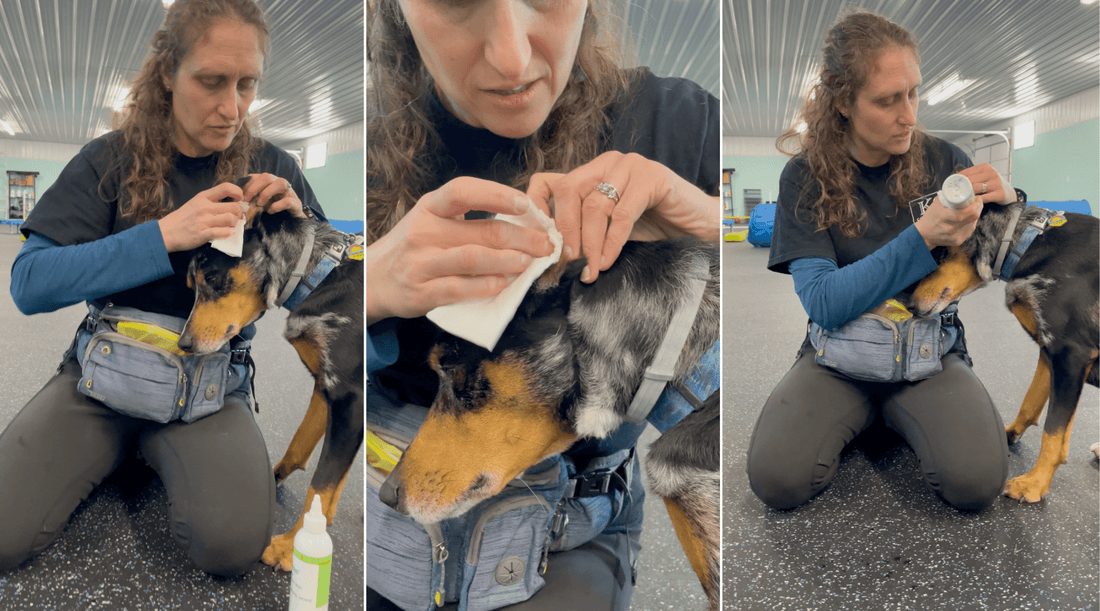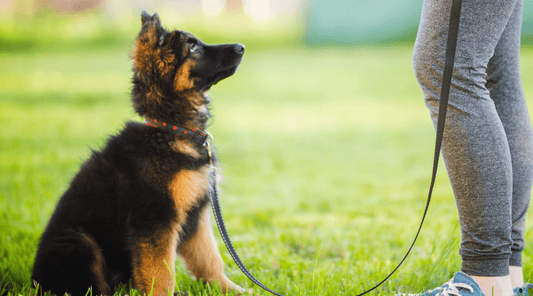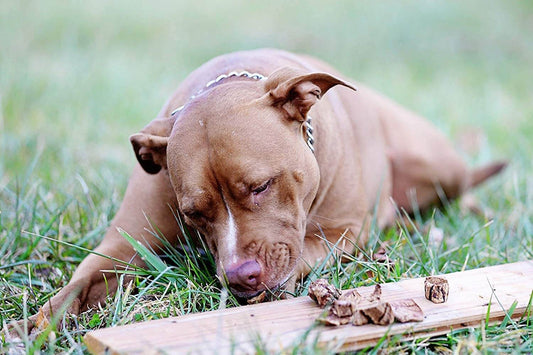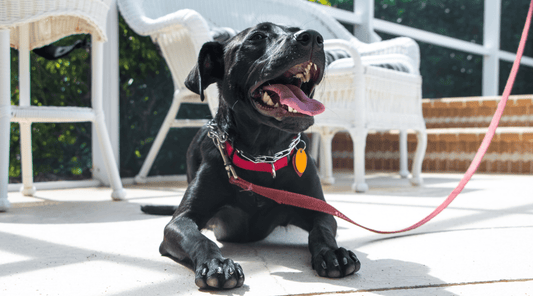
How to Clean a Dog’s Ears: A Battle of Wits, Wax & Wiggles
Dawn Miller Mar 28, 20254 Minute ReadCleaning dog ears isn't at the top of my favorite things list. But I understand its importance to dog health and happiness. No one likes having excess moisture or buildup in the ear.
Last week, I noticed Pixie shaking her head a little too much. At first, I thought she was just being dramatic (as terriers tend to be). But then Bruno started sniffing her ears like he thought a chipmunk had taken up residence there. That’s when I knew—it was ear-cleaning time.
Now, if you've ever tried cleaning dog ears, you know it can go one of two ways:
- Smooth as butter—Quick wipe. Happy dog. Treats all around.
- Complete chaos—Your dog transforms into a flailing tornado. You somehow end up with ear cleaner in your hair.
Good news? The latter becomes a lot less frequent with these dog ear cleaning tips.
Why Cleaning Dog Ears Is Important
Dogs love sticking their noses (and ears) where they don't belong. Whether it’s mud puddles, bushes, or Bruno’s obsession with rolling in mystery smells at the park (Bruno, No!), their ears pick up a lot of pollen, dirt, leaf fragments, bugs, and who knows what.
Regular cleanings can:
- Remove these before they cause problems
- Prevent infections
- Eliminate wax buildup
- Catch issues (like mites or infection) before they become a vet visit
How to Tell If Your Dog’s Ears Need Cleaning
I check my dogs’ ears during cuddle time. When approached gently, my dogs just see it as a display of affection. Who doesn't like a good ear rub—if you're a dog?
Here’s what I look for:
🚩Redness or swelling
🚩 Strong odor (dog ears should not smell like a locker room, fish, sourdough starter)
🚩 Dark, gunky wax buildup (It's good to see some clean, light wax because it keeps debris and bugs from going deep in the canal. But once it's dark, it's done all it can.)
🚩 Scratching or head shaking
If you notice constant head shaking, head-scratching, or pus, skip the cleaning. Schedule a vet appointment.
How Often to Clean a Dog’s Ears
It depends on your dog's ear shape, outdoor habits, and history of infection. Here's a general guide to get you on track.
- Floppy-eared dogs (like Basset Hounds, Cocker Spaniels) – Up to once a week
- Dogs with upright ears (like German Shepherds, Huskies) – Every few weeks
- Allergy-prone or swimming dogs – Up to once a week or after every swim in lakes/rivers.
- Dogs who have weak immune systems — Up to once a week...but let's also work on enhancing dog nutrition to improve immune function.
- Dogs with healthy, no-dark wax buildup ears – Check regularly, but clean only as needed.
Remember: Wax belongs in the canal. It's protective. Don't overdo it. Over-cleaning can cause irritation. So, if your dog’s ears look clean and odor-free, you can skip this week.
What You Need for Cleaning Dog Ears
Before you start digging in there, let's make sure you have the right gear for the job:
- A vet-approved ear cleaner (no hydrogen peroxide —very irritating)
- Cotton balls or gauze (no Q-tips—those push waxed-up debris deeper. Ears naturally push the dirty wax toward the surface where you can get rid of it. If the wax is still down in the canal, consider it off-limits. If it looks particularly nasty down in there, it's time to see the vet.)
- Towel (for inevitable head shaking after you add the cleaner)
- High-value dog treats (because bribery works reward calm behavior.)
At first, you might give them a treat after each step—and then after each ear when they start to get it. Then, when we're all done, I give them a meaty dog bone.
High-value treats serve the double purpose of reinforcing good behavior and generating positive associations with dog ear cleaning.
Believe it or not, my dogs look forward to it. And it's a battle of wits and wax no more.
How to Clean a Dog’s Ears
1. Get Your Dog Comfortable
Pick a quiet place. If you can sit on the floor or on the lawn with this, that's really best because ear cleaner drips. But sometimes I do this on the sofa with a towel laid out.
Now, some dogs love ear rubs. Others act like you’re trying to steal their soul. If your dog is the dramatic type, have treats ready to make it positive. They'll come around.
Before you start digging in, get your dog accustomed to being touched on the ears. This is a critical step in puppy socialization. But dogs of any age can learn ear-touch by you or the vet is a good thing.
Do several dry runs before the real deal. Just touch for a few minutes, give them treats, and then no cleaning.
2. Inspect the Ears
Gently lift the ear flap and check for wax buildup, redness, or an off-putting smell. If you see thick discharge or inflammation, call your vet before cleaning.
3. Apply the Ear Cleaner
Squeeze the cleaner into the ear canal. But don’t jam the tip inside. Just let the liquid flow in.
4. Massage the Ear Base
Give the base of the ear a gentle rub for around 30 seconds—you’ll hear a squishy sound. This helps break up wax and debris so that the ear's natural evacuation system can push the old wax toward the surface where you can get it.
It's important to realize that this takes time. So, drops in the ears today may not get all of it out. But they are making the next cleaning more productive.
5. Let the Head Shake Happen
Don't punish the headshake. It's normal. And it helps some of that broken-up wax work its way out.
Step back and let your dog do the dramatic head shake—it’s messy, but it helps remove gunk.
6. Wipe Away Residue
Use a cotton ball or gauze to wipe the outer part of the ear. Never stick anything deep inside the canal.
Dogs have a curve in the ear canal that humans don't. It prevents access to the eardrum. But there's still the risk of pushing stuff in deeper. Only a professional should attempt a deeper clean.
7. Treat and Praise
End on a high note. Give a dog treat and plenty of praise so they associate ear cleaning with good things.
The end of an ear cleaning is the perfect time for a substantial reward like a marrow-filled dog bone.
This whole process takes around 2-3 minutes if you do it regularly.
To learn more about how positive reinforcement training makes everyday dog care easier and fun, Join the 7-Day Dog Training Challenge!
👉 Sign up here: K9 Connoisseur's 7-Day Training Challenge
How Diet Affects Ear Health
A healthy diet can prevent many ear problems before they start.
Too many carbs = yeast buildup (which can lead to infections).
So, avoid dog treats with lots of filler and added sugar. I get single-ingredient dog treats—beef lung bites.
High-protein diets = better immune support
Dogs need protein and get the bare minimum from kibble. Supplement it with a high-protein dog treat.
Omega-3 fatty acids = less inflammation
Grass-fed beef dog bones are a great source of omega 3 and omega 6 for healthy immune function.
Available On:


Disclosure: This article may contain affiliate links, which means we may earn a small commission if you make a purchase through these links—at no extra cost to you. We only recommend products we trust and believe will benefit you and your K9.



